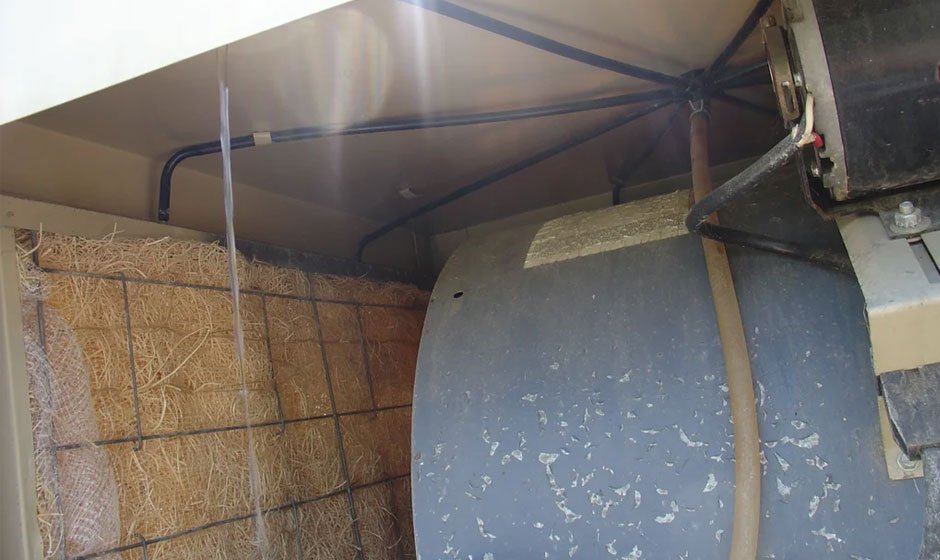Evaporative coolers, also known as swamp coolers, are a cost-effective and environmentally friendly way to cool your home, especially in dry climates. These coolers work by drawing warm air through water-saturated pads, which cool the air through evaporation. Over time, however, these pads can accumulate calcium deposits and other mineral build-ups, which can reduce the cooler’s efficiency. In this blog post, we will explore effective methods for cleaning evaporative cooler pads, specifically focusing on removing calcium deposits.
Understanding Calcium Deposits in Evaporative Cooler Pads
Calcium deposits, often referred to as “hard water deposits,” occur when the minerals in hard water accumulate on surfaces over time. This build-up can clog the porous material in evaporative cooler pads, reducing its ability to absorb water and cool the air effectively. Signs of calcium deposits include decreased cooling efficiency, foul odors, and visible white or grayish residue on the pads.
Materials Needed
Before you begin cleaning your swamp cooler pads, gather the following materials:
- Gloves
- Protective eyewear
- Garden hose with a nozzle
- Large bucket or basin
- White vinegar
- Soft scrub brush
- Plastic putty knife
- Replacement cooler pads (optional)
Step-by-Step Guide to Cleaning Evaporative Cooler Pads
Step 1: Safety First
Before starting any cleaning procedure, ensure your swamp cooler is turned off and unplugged. Wear gloves and protective eyewear to shield yourself from any debris or cleaning agents.
Step 2: Remove the Pads
Carefully remove the cooler pads from the unit. Depending on your specific cooler model, this may involve opening a panel or accessing the pads from the outside of the cooler.
Step 3: Rinse with Water
Using a garden hose with a nozzle attachment, gently spray down the pads to remove loose debris, dust, and dirt. Start from the top of the pads and work your way down to ensure thorough cleaning.
Step 4: Soak in Vinegar Solution
Fill a large bucket or basin with a mixture of equal parts water and white vinegar. Submerge the cooler pads completely in the solution and let them soak for 1 to 2 hours. Vinegar effectively breaks down mineral deposits like calcium without damaging the pads.
Step 5: Scrub Gently
After soaking, use a soft scrub brush to gently scrub the pads, focusing on areas with visible calcium deposits. Avoid using abrasive materials that could tear or damage the pads.
Step 6: Rinse and Air Dry
Thoroughly rinse the pads with clean water to remove the vinegar solution and loosened deposits. Allow the pads to air dry completely before reinstalling them in the evaporative cooler.
Step 7: Inspect and Replace (if necessary)
Inspect the cleaned pads for any remaining deposits or signs of wear. If the pads are heavily damaged or if cleaning does not restore their effectiveness, consider replacing them with new ones. Replacement pads are typically available from hardware stores or online retailers.
Additional Tips for Maintaining Evaporative Cooler Pads
- Regular Cleaning:Clean your cooler pads at least once per season or more frequently if you notice reduced cooling efficiency.
- Water Quality:Use distilled or softened water in your evaporative cooler to minimize mineral build-up.
- Check Water Levels:Ensure the water level in your cooler is maintained according to manufacturer recommendations to prevent dry pads from accumulating deposits.
Preventing Calcium Deposits
Prevention is key to reducing calcium deposits on swamp cooler pads. Here are some preventive measures you can take:
- Water Treatment:Use a water treatment product specifically designed for evaporative coolers. These products help inhibit mineral build-up and extend the lifespan of cooler pads.
- Routine Maintenance:Regularly inspect and clean your evaporative cooler throughout the cooling season. Addressing any issues promptly can prevent mineral build-up from becoming severe.
- Adjust Water pH:Monitor and adjust the pH level of the water used in your cooler. Keeping the pH slightly acidic can discourage mineral precipitation.
- Install a Water Softener:If your tap water is exceptionally hard, consider installing a water softener. Softened water contains fewer minerals, reducing the likelihood of calcium deposits.
Conclusion
Cleaning calcium deposits from swamp cooler pads is essential for maintaining the efficiency and longevity of your evaporative cooler. By following these steps and incorporating regular maintenance into your cooling system care routine, you can ensure optimal performance and cool, refreshing air during the hot summer months. Remember, safety is key when handling cleaning solutions and equipment. If you have any doubts or concerns about cleaning your swamp cooler, consult the manufacturer’s guidelines or contact a professional HVAC technician for assistance.
Now that you know how to clean evaporative cooler pads and prevent calcium deposits, take the time to give your swamp cooler the care it needs to keep you cool and comfortable all season long! If you have any additional tips or experiences with cleaning swamp cooler pads, feel free to share them in the comments below. Your insights could help others maintain their evaporative coolers effectively.
For more home maintenance tips and cooling solutions, subscribe to our newsletter and stay tuned for future updates. Thank you for reading!

